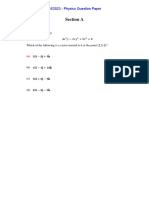0 ratings0% found this document useful (0 votes)
39 viewsProblem Set I
This document contains 4 physics problems related to nanoscale devices. Problem 1 involves calculations in the Drude model of electrical conductivity. Problem 2 examines energy loss in collisions using the Drude model. Problem 3 analyzes a 2D free electron gas model. Problem 4 involves calculations of density of states and electron concentration for a particle confined in a thin slab.
Uploaded by
right12351Copyright
© © All Rights Reserved
Available Formats
Download as PDF, TXT or read online on Scribd
0 ratings0% found this document useful (0 votes)
39 viewsProblem Set I
This document contains 4 physics problems related to nanoscale devices. Problem 1 involves calculations in the Drude model of electrical conductivity. Problem 2 examines energy loss in collisions using the Drude model. Problem 3 analyzes a 2D free electron gas model. Problem 4 involves calculations of density of states and electron concentration for a particle confined in a thin slab.
Uploaded by
right12351Copyright
© © All Rights Reserved
Available Formats
Download as PDF, TXT or read online on Scribd
You are on page 1/ 2
Physics of Nanoscale Devices-II
Problem Set-I
1. In Drude model the probability of an electron suffering a collision in any infinitesimal
interval is just / .
a. Show that an electron picked at random at a given moment had no collision during
/
the preceding seconds with probability . Show that it will have no collision
during the next seconds with the same probability.
b. Show that the probability that the time interval between two successive collisions
of an electron falls in the range between and + is ( / ) / .
c. Show as a consequence of (a) that at any moment the mean time back to the last
collision (or up to the next collision) averaged over all electrons is .
d. Show as a consequence of (b) that the mean time between successive collisions of
an electron is .
2. Consider a metal at uniform temperature in a static uniform electric field E. An electron
experiences a collision, and then, after a time , a second collision. In the Drude model,
energy is not conserved in collisions, for the mean speed of an electron emerging from a
collision does not depend on the energy that the electron acquired from field since the time
of the preceding collision.
a. Show that the average energy lost to the ions in the second of two collisions
separated by a time is ( ) /2 . (The average is over all directions in which
the electron emerged from the first collision.)
b. Show, using the result of Problem 1(b), that the average energy loss to the ions per
electron per collision is ( ) / , and hence that the average loss per cubic
centimeter per second is ( / ) = . Deduce that the power loss in a wire
of length and cross section is , where is the current flowing and is the
resistance of the wire.
3. The free and independent electron gas in two dimensions:
a. What is the relation between and in 2-D?
b. What is the relation between and in 2-D?
c. Prove that in 2-D the free electron density of levels () is a constant independent
of for > 0, and 0 for < 0. What is the constant?
d. Show that because () is constant, every term in the Sommerfeld expansion for n
vanishes except the = 0 term. Deduce that = at any temperature.
e. Deduce from = () () that when () is as in (c), then
/
+ ln 1 + =
4.
a. Find out the total number of states present in the conduction band per unit volume
within the energy range of above the conduction band minima.
b. Suppose a particle is confined in a thin slab (figure given below). These particles
are confined in the z-direction, but they are free to move in x-y plane. If the
thickness of the slab is then find out the expression of DOS for the system and
draw it. Also find out the 2-D electron gas concentration.
You might also like
- Ashcroft, Neil W, Mermin, David N - Solid State Physics - SolutionsNo ratings yetAshcroft, Neil W, Mermin, David N - Solid State Physics - Solutions7 pages
- Feynman Lectures Simplified 2C: Electromagnetism: in Relativity & in Dense MatterFrom EverandFeynman Lectures Simplified 2C: Electromagnetism: in Relativity & in Dense MatterNo ratings yet
- PHZ 5941 Condensed Matter I Problem Set 1 - SolutionNo ratings yetPHZ 5941 Condensed Matter I Problem Set 1 - Solution6 pages
- Ph.D. Qualifying Examination Department of Physics and Astronomy Wayne State UniversityNo ratings yetPh.D. Qualifying Examination Department of Physics and Astronomy Wayne State University7 pages
- Electron Beam-Specimen Interactions and Simulation Methods in MicroscopyFrom EverandElectron Beam-Specimen Interactions and Simulation Methods in MicroscopyNo ratings yet
- Chap. 21 The Harmonic Oscillator: 1. Massive Spring (I) : Effective MassNo ratings yetChap. 21 The Harmonic Oscillator: 1. Massive Spring (I) : Effective Mass7 pages
- General Instructions:: Sample Question Paper - 16 Physics (042) Class-XII, Session: 2021-22No ratings yetGeneral Instructions:: Sample Question Paper - 16 Physics (042) Class-XII, Session: 2021-226 pages
- Final physics 12 paper February 2024 SET A(2)No ratings yetFinal physics 12 paper February 2024 SET A(2)6 pages
- IN232 Concepts in Solid State Physics Assignment 2 - Problem 1No ratings yetIN232 Concepts in Solid State Physics Assignment 2 - Problem 11 page
- IN232 Concepts in Solid State Physics Assignment 2 - Problem 1No ratings yetIN232 Concepts in Solid State Physics Assignment 2 - Problem 11 page
- CLASS XII Physics-SQP Academic Session 2024 – 25No ratings yetCLASS XII Physics-SQP Academic Session 2024 – 2541 pages
- Class XII Physics-SQP With MS Academic Session 2024 – 25 (1)No ratings yetClass XII Physics-SQP With MS Academic Session 2024 – 25 (1)47 pages
- Physics- Print- OnLY for SEC-A (38) (1)No ratings yetPhysics- Print- OnLY for SEC-A (38) (1)13 pages
- 025 - PR 01 - Drude Model and Poisson DistributionNo ratings yet025 - PR 01 - Drude Model and Poisson Distribution2 pages
- Vacuum Nanoelectronic Devices: Novel Electron Sources and ApplicationsFrom EverandVacuum Nanoelectronic Devices: Novel Electron Sources and ApplicationsNo ratings yet
- 101 Test in Physics Chemistry and Mathematics Third ShiftNo ratings yet101 Test in Physics Chemistry and Mathematics Third Shift45 pages
- ENEE 313, Fall. '08 Homework II - Due March 30, 2009: N D E DKNo ratings yetENEE 313, Fall. '08 Homework II - Due March 30, 2009: N D E DK2 pages
- Ab Initio Electronic Transport Model With Explicit Solution To The LinearizedNo ratings yetAb Initio Electronic Transport Model With Explicit Solution To The Linearized14 pages
- Physics of Nanoscale Devices - I Physics of Nanoscale Devices - INo ratings yetPhysics of Nanoscale Devices - I Physics of Nanoscale Devices - I3 pages
- EE-733 (Solid State Devices) : Physical FoundationsNo ratings yetEE-733 (Solid State Devices) : Physical Foundations4 pages
- The Density of Atoms in The Silicon Lattice Is of The Order ofNo ratings yetThe Density of Atoms in The Silicon Lattice Is of The Order of13 pages
- EE-733 (Solid State Devices) : Physical FoundationsNo ratings yetEE-733 (Solid State Devices) : Physical Foundations4 pages
- Basic Introduction To Single Electron TransistorNo ratings yetBasic Introduction To Single Electron Transistor5 pages
- EE-733 (Solid State Devices) : Physical FoundationsNo ratings yetEE-733 (Solid State Devices) : Physical Foundations7 pages
- Most of The Electrons (Holes) in A Moderately N (P) Doped Bar of Silicon at Room Temperature Come FromNo ratings yetMost of The Electrons (Holes) in A Moderately N (P) Doped Bar of Silicon at Room Temperature Come From12 pages
- Physics 231 Electrons in A Weak Periodic PotentialNo ratings yetPhysics 231 Electrons in A Weak Periodic Potential6 pages
- 1) From Wikipedia, Empty Lattice Approximation: Band StructuresNo ratings yet1) From Wikipedia, Empty Lattice Approximation: Band Structures2 pages
- Malvern Panalytical Model Slides - AnnotatedNo ratings yetMalvern Panalytical Model Slides - Annotated2 pages
- Reversible Switching of Electromagnetically Induced Transparency in Phase Change MetasurfacesNo ratings yetReversible Switching of Electromagnetically Induced Transparency in Phase Change Metasurfaces10 pages
- Gravity Separation-Old Technique-New Methods PDFNo ratings yetGravity Separation-Old Technique-New Methods PDF19 pages
- Science 9 - Q2 - Mod1 - Electronic Structure of Matter - VerFinal90% (39)Science 9 - Q2 - Mod1 - Electronic Structure of Matter - VerFinal34 pages
- 6th International Symposium On Deformation Characteristics of Geomaterials Argetina 201550% (4)6th International Symposium On Deformation Characteristics of Geomaterials Argetina 20151,236 pages
- Buy Ebook Fundamentals of Nonlinear Optics, Second Edition Peter E. Powers Cheap Price100% (6)Buy Ebook Fundamentals of Nonlinear Optics, Second Edition Peter E. Powers Cheap Price62 pages
- ELEMENTS COMPOUND AND MIXTURE FROM LAKHMIR SINGH SCIENCE BOOK SUMMARYNo ratings yetELEMENTS COMPOUND AND MIXTURE FROM LAKHMIR SINGH SCIENCE BOOK SUMMARY4 pages
- Organic MCQ 2010 ANS Updated 22-05-2013No ratings yetOrganic MCQ 2010 ANS Updated 22-05-2013100 pages















































































































